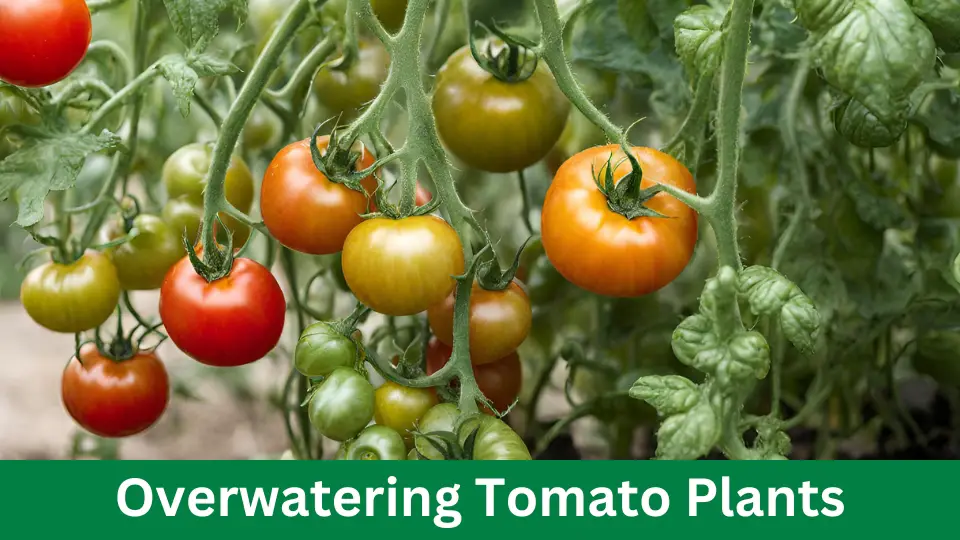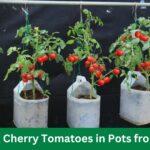Overwatering tomato plants can lead to root rot and nutrient leaching, causing stunted growth and yellowing leaves. This can be detrimental to the overall health and productivity of the plants.
Proper watering practices are essential for the successful cultivation of tomato plants. Understanding the signs of overwatering, implementing a well-drained soil mix, and monitoring moisture levels are vital to prevent overwatering. We will explore the effects of overwatering on tomato plants, signs to look out for, and practical tips for maintaining optimal soil moisture levels.
By following these guidelines, gardeners can ensure the plants’ healthy development and abundant yields. Let’s delve into overwatering and how to manage your thriving tomato plants effectively.
Understanding Overwatering Tomato Plants
Overwatering is a common mistake that harms tomato plants. It’s imperative to understand the signs of overwatering, as it can lead to various issues and negatively impact your plant’s health and fruit production. Let’s look at how overwatering affects tomato plants.
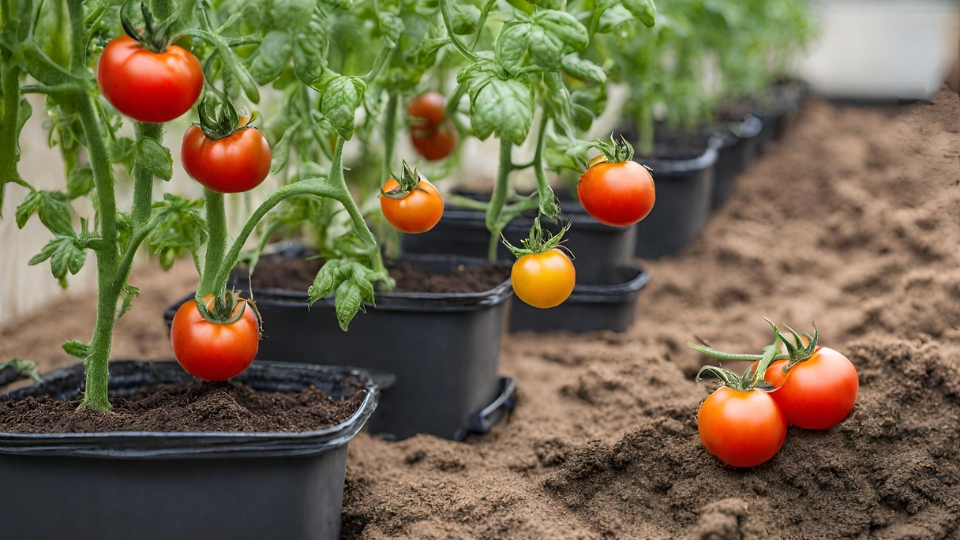
Signs Of Overwatering
Overwatering can cause several visible signs in tomato plants. These signs include yellowing leaves, wilting, and stunted growth. Additionally, the soil may appear constantly moist and have a sour odor. Identifying these signs early is crucial to prevent further damage to the plants.
Yellowing Leaves
One of the most common effects of overwatering is the occurrence of yellowing leaves. This is typically caused by root suffocation due to excessive water in the soil, which impedes the plant’s ability to absorb nutrients, leading to chlorosis in the leaves. If left unaddressed, yellowing leaves can progress to further damage and plant stress.
Effects On Plant Health
Overwatering can seriously impact the overall health of tomato plants. It weakens the plant by hindering nutrient uptake and reducing oxygen circulation, leading to susceptibility to pests and diseases. This can ultimately result in stunted growth and poor resilience in environmental stressors.
Root Rot And Fungal Diseases
Overwatering creates a favorable environment for root rot and fungal diseases. Excess moisture in the soil causes the roots to rot, weakening the plant’s foundation and making it more susceptible to fungal infections, such as Fusarium and Pythium. These diseases can quickly spread, causing severe damage to the plant.
Impact On Fruit Production
Overwatering directly affects the yield and quality of tomato fruits. It can lead to blossom end rot, fruit cracking, and poor fruit set. Furthermore, overwatered plants may produce fruits that are less flavorful and unappealing in appearance, ultimately affecting the market value of the harvest.
Reduced Yields And Taste
The consequences of overwatering extend to reduced yields and tomato flavor. Excessive water can dilute the flavor compounds in the fruit, resulting in a less flavorful taste. Moreover, it hinders the natural ripening process, affecting the overall quality of the harvest.
Preventing Overwatering
Overwatering can harm tomato plants, leading to root rot, nutrient leaching, and stunted growth. Preventing overwatering involves employing proper watering techniques, selecting the suitable soil, and using moisture regulation methods such as mulching. Here are some essential strategies to avoid overwatering and to promote the optimal growth of tomato plants.
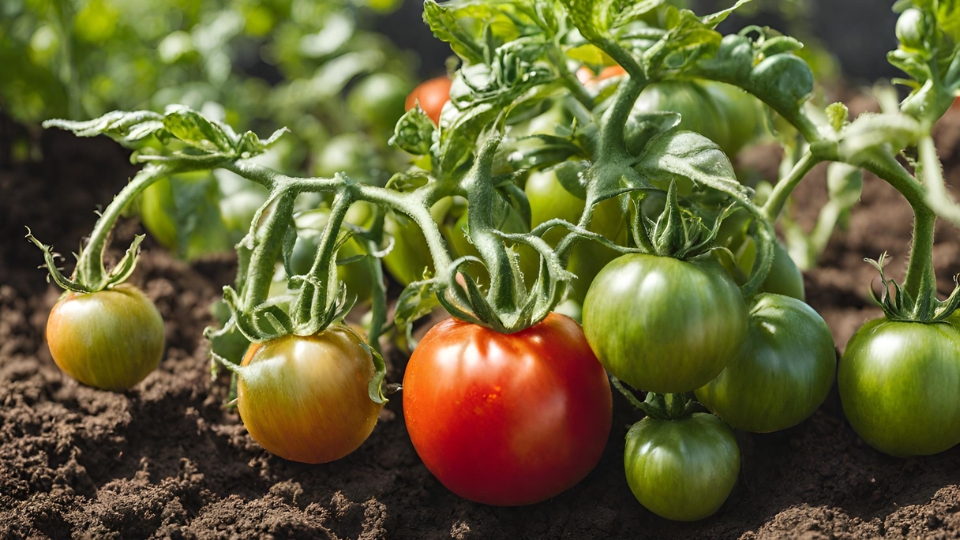
Proper Watering Techniques
Proper watering involves providing the right amount of water at the right time to avoid overwatering. Water only when the top inch of soil is dry to the touch, and water slowly to allow deep penetration and thorough root absorption.
Deep Watering Vs. Shallow Watering
Understanding the difference between deep watering and shallow watering is crucial. Deep watering encourages deep root growth, leading to a more drought-tolerant plant, while shallow watering results in a superficial root system that is more susceptible to overwatering. Deep watering ensures the water reaches the root zone, promoting better moisture retention.
Choosing The Right Soil
Choosing the suitable soil is essential in preventing overwatering. Opt for a well-draining potting mix that allows excess water to drain away, preventing soggy conditions that can lead to overwatering. A sandy loam or loamy soil promotes effective drainage, reducing the risk of overwatering.
Well-draining Soil Mixtures
Ensure that the soil mixtures used for tomato plants are well-draining. Incorporate perlite or vermiculite into the soil to improve drainage and prevent water from accumulating around the roots. This promotes a healthy root system and reduces the likelihood of overwatering.
Using Mulch For Moisture Regulation
Mulching around tomato plants helps regulate moisture levels by reducing evaporation and maintaining soil moisture. Organic mulches such as straw or shredded bark can be applied to the soil surface to retain moisture and prevent excessive watering. Additionally, mulch aids in weed suppression and soil insulation.
Monitoring Soil Moisture
Monitoring soil moisture is crucial to prevent overwatering when growing healthy tomato plants. Overwatering can lead to root rot, nutrient leaching, and stunted growth.
By monitoring the soil moisture levels, you can ensure that your tomato plants receive the right amount of water for optimal growth.
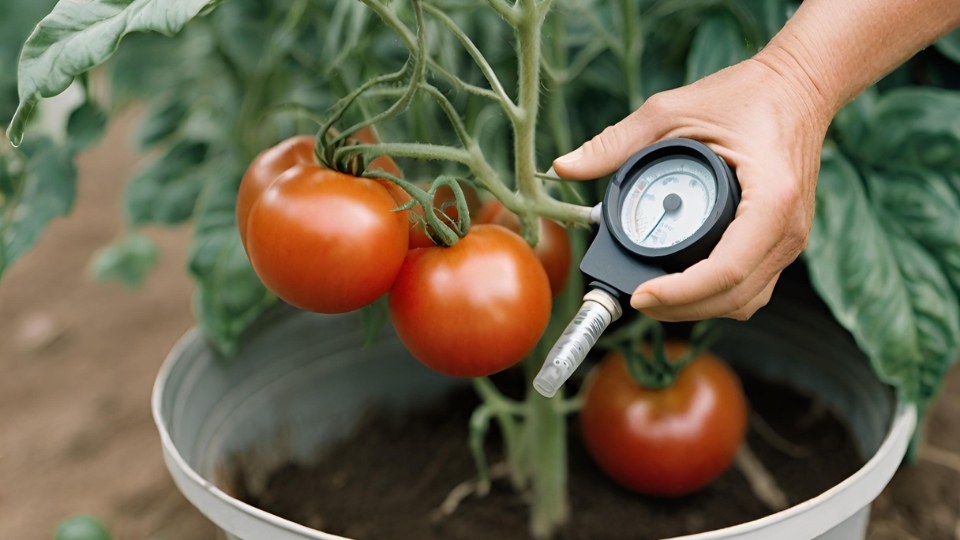
Tools For Testing Moisture Levels
Before delving into the ideal soil moisture levels, having the right tools for testing them is essential. Various tools are available for this purpose, including moisture meters and probes, which provide accurate readings of the soil moisture content.
Moisture Meters And Probes
Moisture meters and probes are indispensable tools for determining the moisture status of the soil. These devices allow you to monitor the moisture levels at different depths, enabling you to make informed decisions about watering your tomato plants only when necessary.
Ideal Soil Moisture Levels
The ideal soil moisture levels for healthy tomato plant growth are typically between 60-80% of the soil’s water-holding capacity. This range ensures that the roots can access sufficient water without being waterlogged, promoting robust and vigorous plant development.
Balancing Moisture For Healthy Growth
To maintain healthy growth, it’s essential to strike a balance regarding soil moisture. This can be achieved through regular monitoring and adjusting your watering schedule based on the moisture readings. Keeping the soil moisture levels within the ideal range allows you to foster the optimal environment for your tomato plants to thrive.
Adjusting Watering Frequency
Adjusting the watering frequency based on the plant’s specific needs is crucial to prevent overwatering tomato plants. Monitoring the soil moisture and the weather conditions can help determine the right balance, ensuring the plants receive adequate water without being overwatered.
Adjusting Watering Frequency Proper watering is essential for tomato plants’ healthy growth and productivity. Overwatering can lead to root rot, wilting, and reduced fruit production. Understanding the seasonal watering needs and responding to weather conditions is crucial for adjusting the watering frequency of tomato plants.
Seasonal Watering Adjustments
Tomato plants generally require more frequent watering in the summer due to the higher temperatures. The hot weather causes the soil to dry out more quickly. However, as the fall season approaches, the watering frequency should be adjusted to accommodate the cooler temperatures.
Summer vs. Fall Watering Needs
During the summer, tomato plants may need to be watered every 2-3 days, depending on the specific weather conditions and soil moisture levels.
As the temperatures decrease in the fall, the watering frequency can be gradually reduced to every 4-5 days. This adjustment ensures that the plants receive sufficient moisture without being overwatered.
Responding to Weather Conditions
In response to extreme weather conditions such as heat waves or sudden temperature drops, monitoring the soil moisture levels and adjusting the watering frequency accordingly is essential.
During heatwaves, more frequent watering may be necessary to prevent the soil from drying out, whereas in the case of sudden temperature drops, reducing the watering frequency can help prevent waterlogged soil.
Rainfall and Temperature Considerations
Monitoring the rainfall levels is crucial for adapting the watering schedule. If there has been substantial rainfall, the need for additional watering may be reduced. Conversely, supplemental watering may be required during drier periods to maintain adequate soil moisture.
Additionally, temperature fluctuations should be considered when adjusting the watering frequency, as higher temperatures can lead to increased evaporation and may necessitate more frequent watering. By considering seasonal changes, weather conditions, and rainfall levels, gardeners can effectively adjust the watering frequency for tomato plants to ensure optimal growth and yield.
Reversing Overwatering Damage
Overwatering can lead to many problems for tomato plants, causing the roots to suffocate and potentially leading to root rot. However, all hope is not lost when dealing with overwatered tomato plants. With the right techniques and treatments, it is possible to reverse the damage and restore plant health.
Salvaging Overwatered Plants
Prompt action is crucial if you notice signs of overwatering in your tomato plants, such as wilting, yellowing leaves, or stunted growth. The first step is to assess the extent of the damage and implement corrective measures to salvage the plants.
Trimming And Re-establishing Balance
One effective method for salvaging overwatered tomato plants is trimming away damaged or rotting roots. This helps to eliminate the source of stress and allows the plant to redirect its energy towards healthy growth. Additionally, re-establishing a balance in watering frequency and soil moisture levels is essential to prevent further damage.
Remedies For Root Rot
Root rot is a common issue in overwatered plants, including tomatoes. It’s essential to improve soil drainage and provide adequate aeration to the roots to combat root rot. Moreover, incorporating beneficial microbes and organic matter into the soil can help inhibit the growth of root rot pathogens and promote root health.
Natural And Chemical Treatments
When dealing with overwatering damage, various natural and chemical treatments can be employed to aid in recovery. Natural remedies, such as compost tea drench, can boost the plant’s immune system and encourage root regeneration. On the other hand, chemical treatments, like fungicides, can be considered for severe cases of root rot, provided they are applied carefully and per labeling instructions.
Practical Tips For Care
Proper watering is crucial for the health and productivity of tomato plants. Overwatering can lead to root damage, nutrient leaching, and the development of diseases. Here are some practical tips for caring for your tomato plants to ensure they receive the right amount of water.
Observing Plant Behavior
Observing the behavior of your tomato plants is crucial in determining their water needs. Healthy tomato plants generally have vibrant green leaves, while wilting leaves may indicate the need for more water. Additionally, inspect the soil; if it feels excessively damp, it’s a sign of overwatering.
Telling Signs Of Under Or Overwatering
- Underwatering: Shriveling leaves, slow growth, and dry soil.
- Overwatering: Yellowing leaves, root rot, and a musty odor emanating from the soil.
Establishing A Routine
Developing a consistent watering routine is essential for the health of your tomato plants. Aim to water in the early morning to allow foliage to dry before nighttime, reducing the risk of diseases. This also ensures that plants have access to water during the heat of the day when they need it most.
Consistent Watering Schedules
Establishing a consistent watering schedule is crucial. During the hotter months, aim to water every two to three days, adjusting for weather conditions and plant maturation. Deep watering is more beneficial than frequent shallow watering as it encourages more profound root growth and drought tolerance.
Frequently Asked Questions Of Overwatering Tomato Plants
How Does Overwatering Affect Tomato Plants?
Overwatering can lead to root rot, deprive plants of oxygen, and hinder nutrient absorption. It can also make plants vulnerable to diseases and pests, impacting overall health and productivity.
What Are The Signs Of Overwatering In Tomato Plants?
Watch for wilting, yellowing leaves, and moldy growth, which indicate overwatering in tomato plants. Additionally, the soil may appear waterlogged and have a sour odor, signaling excessive moisture.
How Often Should Tomato Plants Be Watered To Avoid Overwatering?
Water tomato plants deeply but less frequently, aiming for 1-2 inches of water per week. Adjust based on weather conditions and soil moisture levels, ensuring proper drainage to prevent overwatering.
Can Overwatering Stunt The Growth Of Tomato Plants?
Yes, overwatering can hinder the growth of tomato plants by disrupting nutrient uptake and oxygen availability to the roots, leading to stunted growth and reduced productivity. Proper watering is crucial for healthy plant development.
Conclusion
It’s essential to strike the right balance with watering your tomato plants. Overwatering can lead to root rot and other serious issues, so paying close attention to your plant’s specific needs is crucial. By following these tips and closely monitoring your plants, you can ensure they thrive and yield a bountiful harvest.
Video Source Link: https://www.youtube.com/watch?v=KXRb2AnJD_k

